
This article was updated on June 23rd, 2024

There’s almost nothing more adorable than a litter of puppies, with their sweet snuggles and tiny noses. But canine pregnancy is a complex process, requiring extensive knowledge and commitment. Here’s a week-by-week guide (with pictures) with tips from our veterinarians.
Week-by-week pictures of dog pregnancy
The average gestation period for dogs is 63 days (9.0 weeks). This may vary slightly depending on the breed and number of puppies.
Let’s first look at ‘overview pictures’ for weeks 4 to 9, before diving in with more information and pictures for each week:
Overview pictures:
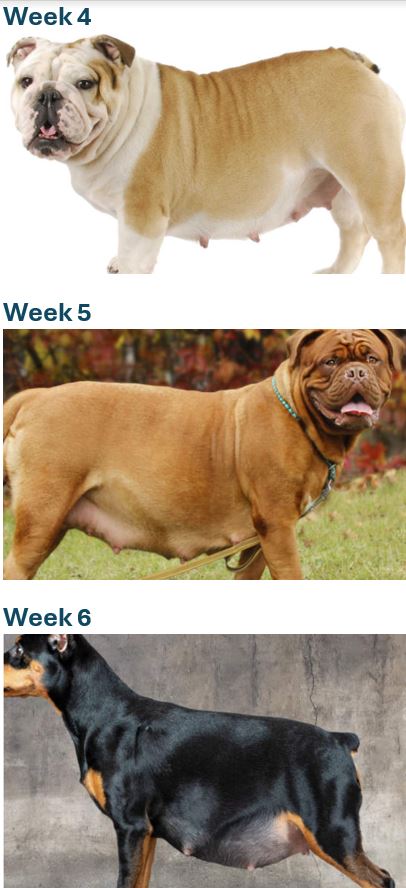
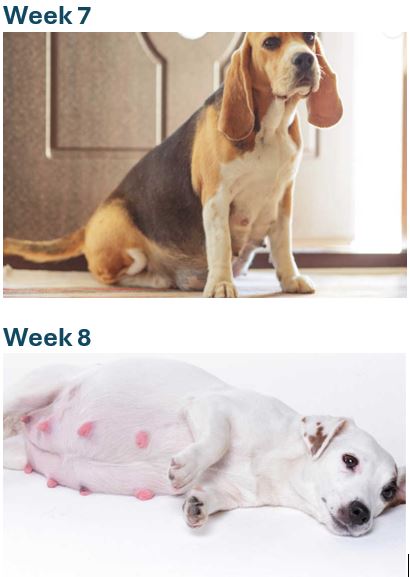
Let’s now look at more information and pictures for each week of the gestation process.
Pictures for weeks 0-3
Not much will change in the first three weeks, so you and your dog can continue your normal routine. Inside her body, however, fertilization is occurring, and blastocysts are developing and making their way to the uterus in preparation for implantation.


Around week three, the embryos have implanted in the uterus, and some dogs may experience morning sickness. While generally not as severe as in human mothers, you may notice the following:
- occasional vomiting,
- lower energy level, and
- decreased appetite.
You can offer small frequent meals to help ease nausea. However, if these signs linger for more than a few days, it is best to consult your vet to make sure there is nothing more serious going on.
At this point, you may still be unsure if your dog is pregnant: on physical exam, your vet may be able to feel fluid-filled sacs on abdominal palpation around days 21 through 35 (weeks 3 to 5). They then become indistinct and difficult to palpate until late pregnancy. There are blood tests that your veterinarian can perform to confirm the pregnancy as well.
Week 4 pictures
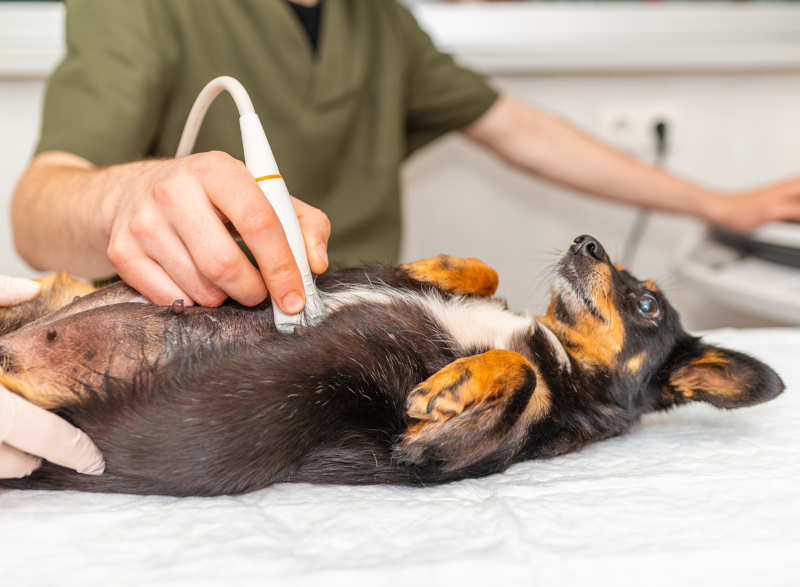
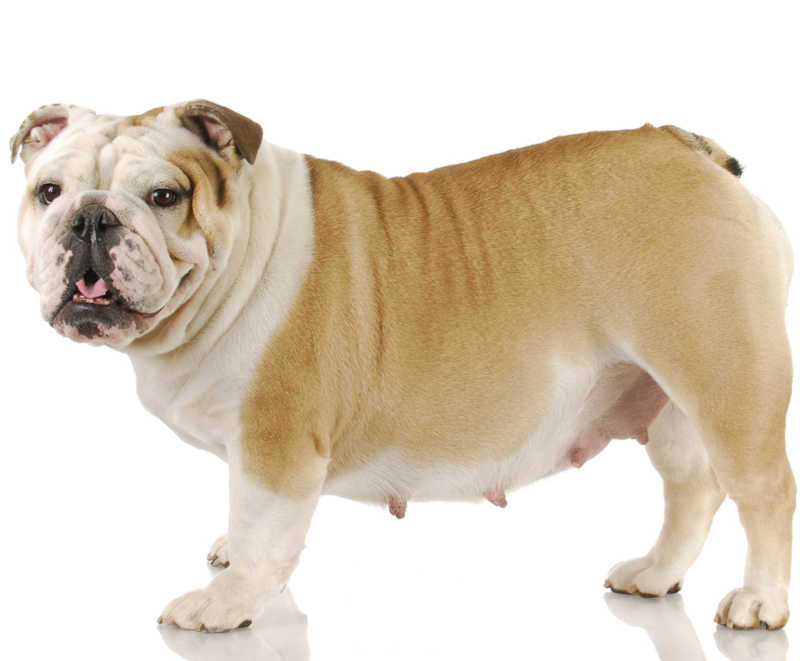
Pregnancy will become more apparent at this stage, with the onset of weight gain and several diagnostic tests available to your vet to help confirm that your dog is expecting. The blood test will look at relaxin levels (produced by the placenta) to detect pregnancy. An ultrasound may be used after days 25-35 to detect fetuses and listen to their heartbeats (which average around 230 beats per minute):
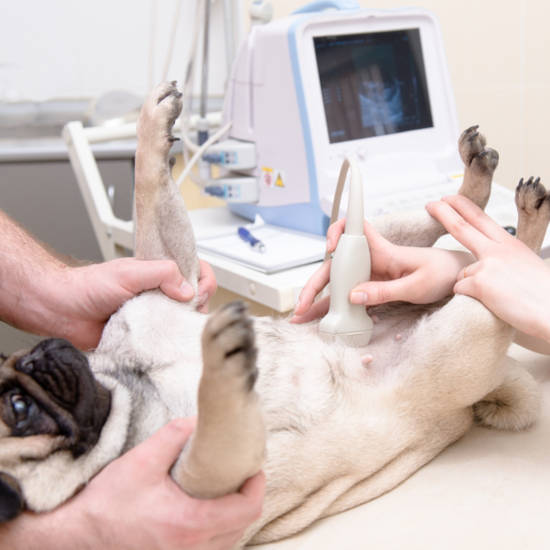
Week 5 pictures
This is the beginning of the fetal stage. The pups’ organs have all begun to develop, and they will begin to grow rapidly now.
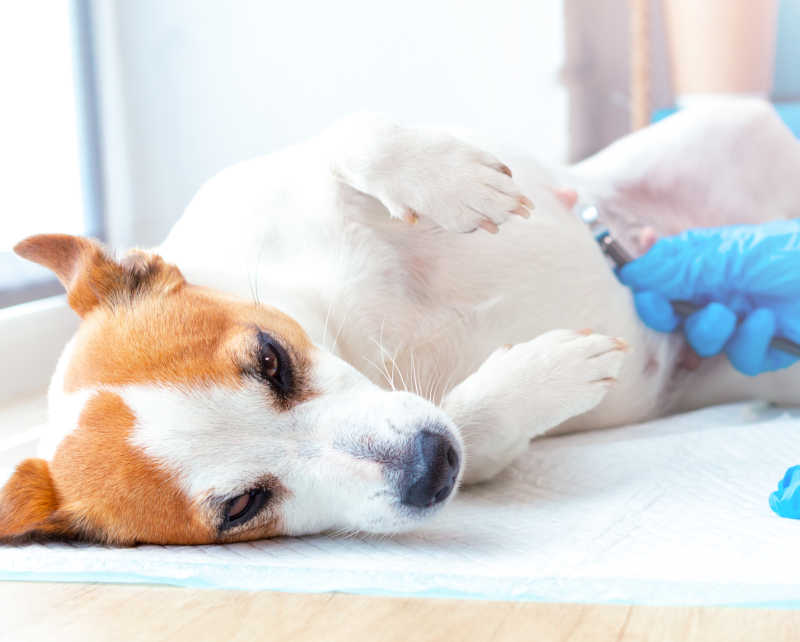

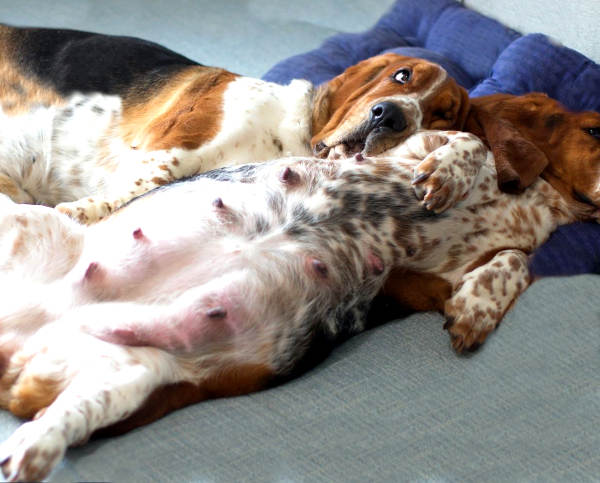
It is important to deworm your dog around this time, to prevent parasites from being passed to the pups. Discuss pregnancy-safe options and a recommended deworming schedule with your vet.
Week 6 pictures
As your dog enters the third trimester around day 45, you will notice many more physical changes, including an increasingly large belly, mammary gland enlargement, and pigmented nipples.

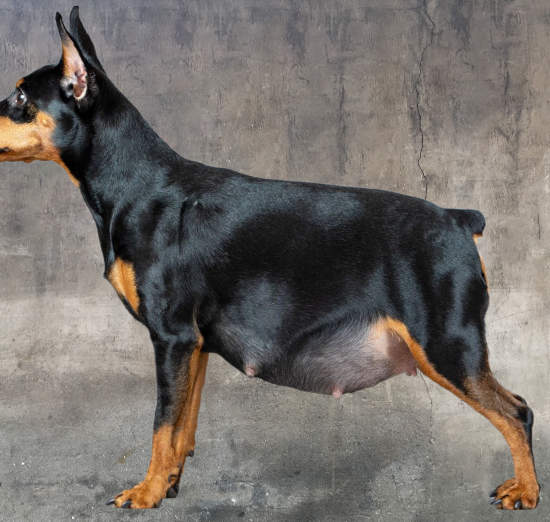
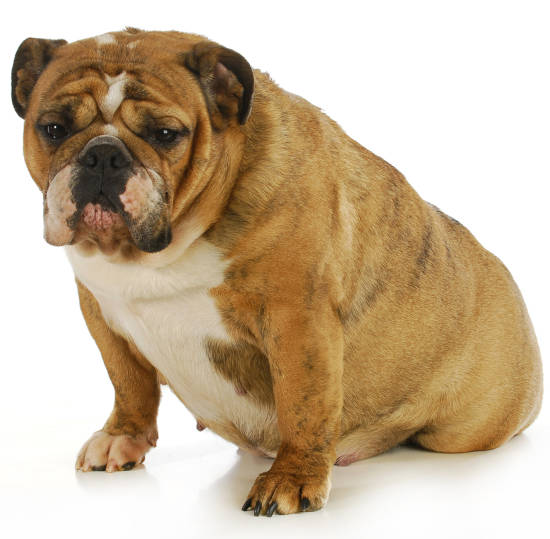
Fetal skeletons will be visible on an x-ray around day 45 as well (as shown on the picture below).

The puppies are now developing rapidly, and the strain on the mom’s body increases significantly. Weight gain will ramp up, and energy requirements will increase to 30-60% higher than usual. Therefore food intake should increase by approximately 1.5 times her normal amount.
At the same time, puppies continue to take up more space making large meals difficult to tolerate. If you haven’t already made the switch, it is now important to feed an easily digestible calorie-dense diet, and to offer small frequent meals. This diet should be approved for pregnancy, lactation, or puppies, and should be continued from now until the pups are fully weaned. Do not feed a large-breed puppy food, as the ratio of calcium and phosphorus is not appropriate at this time.
“While you should avoid strenuous exercises, such as agility or long-distance running, walking is recommended throughout pregnancy.”
Discuss canine herpesvirus with your vet and if you should isolate your pregnant dog from other dogs for the last three weeks of gestation and the first three weeks after giving birth. This disease causes a mild cold in adult dogs, but can cause miscarriage or death in newborns if mom becomes infected.
Week 7 pictures
This is a good time to begin preparing for whelping and make plans for how you will support mom and pups after birth.

X-rays at this stage will be a good indicator of litter size. The pups are continuing to grow and begin to develop fur.
Week 8 Pictures
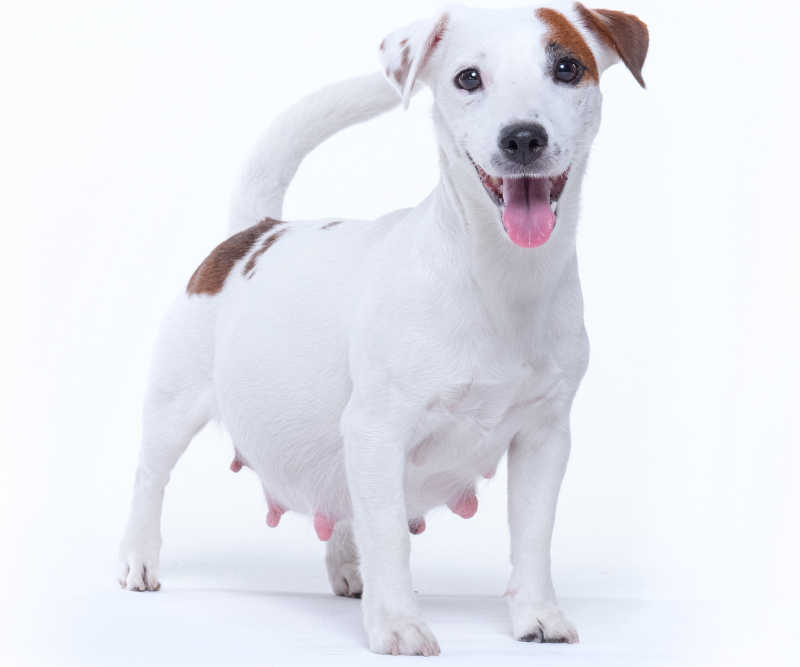

Labor is approaching soon. Discharge from the vulva is common in the last week of pregnancy, however, contact your vet if the discharge appears bloody, thick, purulent (pus-like), or dark green in color. Milk may also begin leaking from the nipples, and you may notice nesting behavior.
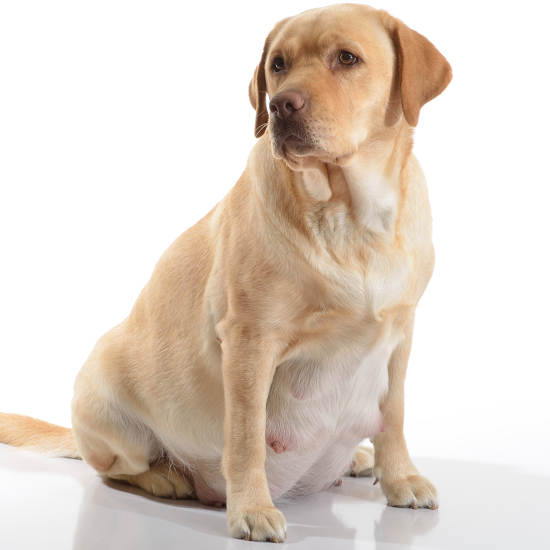
You should begin taking your dog’s temperature rectally two to three times per day. A normal canine temperature is 99.5-102.5F. A temperature drop (to an average of 98.8F) is a good indicator that labor will begin within 24 hours.
“Dogs in their third trimester of pregnancy or who are nursing should eat a high-quality, easily digestible diet that is complete and balanced for pregnancy, lactation, or puppies.”
Week 9 pictures
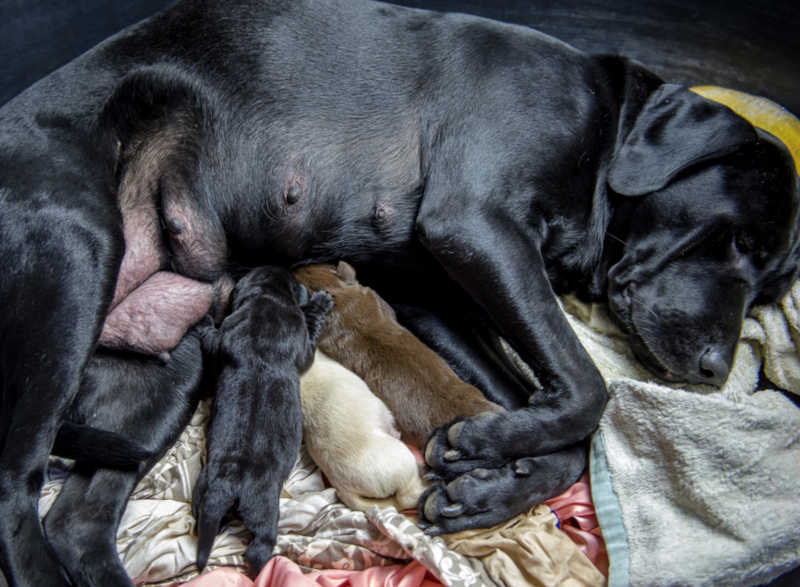
The pups are now fully developed and ready to be born. Within 24 hours of labor:
- rectal temperature will drop 1-2 degrees from normal, and
- your dog may become restless and refuse food.


Fetus Development, Day by Day and Week by Week (Video)
This video from Purina depicts a fetus developing in the womb over the nine weeks of dog pregnancy:
8 Tips From Dr. Liza Cahn (Veterinarian)
1. Feed your dog a new healthy diet
“Good nutrition is critical during and after pregnancy for both mom and pups. Dogs in late pregnancy and those who are nursing must eat a high-quality diet that is complete and balanced for pregnancy, lactation, or puppies (not large breed puppy food), and should eat small frequent meals to keep up with their increased energy requirements.”
Most dogs will develop more of an appetite during pregnancy, once the morning sickness is over. However, you don’t want to feed free choice to every dog as you don’t want them to gain too much weight. Talk to your vet about how much to feed your pup and if increases in amounts or changes in diets are necessary. You may notice that your girl will start to prefer eating smaller amounts more frequently and will save food from larger meals for later.
Avoid additional supplements unless specifically recommended by your vet.
2. Stay up to date on vaccines and parasite prevention
“It is important to make sure your dog is up to date on vaccines and parasite prevention prior to becoming pregnant so that she can pass immunity on to her pups. “
Whether you see signs of worms or not, deworming your pregnant pup is important for her health and the health of her pups. Worms can be passed from mother to puppies in utero so it’s best to have momma dewormed so that the babies will be born healthy and worm-free.
If the pregnancy is accidental or unplanned, be sure to discuss wellness care with your vet, as some products may not be safe for pregnant animals.
3. Plan your veterinary visits.
Be sure to check in with your vet about when and how often they would like to evaluate your dog during her pregnancy and after giving birth. This usually involves:
- an exam before pregnancy,
- an exam and diagnostics to confirm pregnancy and the number of puppies around day 45-55, and
- an exam near the end to discuss preparations for whelping.
4. Be careful with medications.
Illness and contraindicated medications – Pregnant dogs can become sick and face medical issues, and if this occurs, you will need to see your vet. It is important to remember that your vet may be limited in the types of medications that they can give her that are safe for pregnancy and unborn puppies.
5. Keep your dog exercised.
While you should avoid strenuous exercises, such as agility or long-distance running, walking is recommended throughout pregnancy. Maximum weight gain should be no more than 36% of pre-breeding weight, most of which will occur after day 40.
6. Give your dog a quiet, safe spot.
In the last few weeks especially, you may notice that your dog gets more and more restless. She may find it hard to get comfortable. Help her out by giving her a quiet, safe spot with lots of bedding. If you have other animals, keep them out. This should be her space only. Leave a fresh supply of water close by and let her come and go as she pleases.
7. Prepare for birth.
You will need to prepare a whelping box where mom will give birth and care for her pups for the first few weeks. You should also have:
- clean towels,
- newspapers,
- absorbent bedding,
- a digital thermometer, and
- your vet’s phone number on hand.
8. Monitor your dog’s temperature.
You may choose to monitor her temperature to predict when she will start to whelp, or give birth. A female’s temp will actually drop from the normal 101-102⁰ to below 99⁰ about 24 hours before labor starts.
Tell your vet if you notice any change in appetite or behavior, or if you notice any bleeding or abrnomal discharge
Here are some situations where you should call your vet:
- Changes in appetite or behavior in a pregnant dog could be caused by hormonal fluctuations, nutritional deficiencies, or underlying medical conditions.
- Tell your vet about any bleeding or abnormal discharge or foul odor.
- Once your dog goes into labor, tell your vet if a puppy isn’t born within a couple of hours of starting contractions or if there is more than a few hours between puppies.
FAQs
How Long Does a Dog’s Pregnancy last?
The average gestation period is 63 days (9.0 weeks). This may vary slightly depending on the breed and number of puppies. It can also be difficult to predict an exact due date as conception does not always occur on the same day as mating. Therefore, birth can occur 58 to 72 days after mating (about 8-10 weeks).
How Do You Estimate the Due Date?
The due date can be estimated in several ways:
- Dog pregnancy calculator adds 63 days from the time of mating for an approximation of your pup’s due date.
- If your pet has been monitored by a vet to determine the ideal time to breed her, you may be able to get an even more accurate due date based on vaginal cytology and bloodwork indicating the timing of her LH surge and ovulation.
- If you are not sure when mating occurred or if a litter is unplanned, your vet may be able to make an educated guess based on history (for example, if your dog got out of the house one day), x-rays, and abdominal ultrasound.
When Do I Know How Many Puppies My Dog Will Have?
The best way to determine the number of puppies is to have your vet take an x-ray and count the fetal skeletons. The puppies will be visible on an x-ray after day 45 of gestation, but after day 55 is the ideal time to determine litter size. This method is not always completely accurate, depending on how many puppies are present and their positioning, but usually gives a very good indicator of how many pups to expect.
How Do I Know What Stage of Pregnancy My Dog Is In?
You will be able to determine how far along your dog is based on exams and diagnostics from your vet. Pregnancy can be determined in the following ways:
- History and timing of mating
- Physical exam – As pregnancy progresses, your vet will be able to observe physical changes, including weight gain and mammary development. Between 21 and 35 days, they may be able to diagnose pregnancy by feeling fluid-filled sacs in the uterus on abdominal palpation.
- Bloodwork – A blood test to measure the hormone relaxin, produced by the placenta, may be used after approximately 30 days.
- X-rays – After approximately 45 days, fetal skeletons will be visible on radiographs. This is also an excellent way to determine the number of puppies expected.
- Ultrasound – After 25 to 35 days ultrasound can be used to diagnose pregnancy. It can also be used later in the process to assess fetal health and heart rate. Measurements on ultrasound can also help determine gestational age.
Can a Pregnant Dog Jump Around?
Many pregnant dogs will start to restrict their own activity level as they get larger and closer to term. While strenuous exercise (such as agility, long-distance running, and rough play) should be avoided, jumping on and off furniture should not cause a problem. It is important and beneficial to continue to walk your dog. Ask your vet for their specific recommendations for activity during pregnancy.
Can I Hold a Newborn Puppy?
Newborn puppies are born with their eyes and ears closed, and are completely reliant on their mother for the first 2-3 weeks of their life, during which they mostly sleep and nurse. Your new pups will need to have an exam with a vet or may need to be handled for other health and safety reasons, but in general, they should not be handled excessively or separated from mom at this young age.
The socialization window for puppies is from approximately three to 12 weeks of age. During this time, it is beneficial and critical to handle puppies and expose them to new people and situations. Curiosity and willingness to approach and interact with new people and objects should be rewarded. Check out these tips from Purdue University for socializing your litter.
Related posts
References
Concannon, P. (2002). Physiology and Clinical Parameters of Pregnancy in Dogs. Lecture at WSAVA. Retrieved December 6, 2022, from VIN.
Davidson, A. P. (2022, November 10). Pregnancy determination in dogs and cats – management and Nutrition. Merck Veterinary Manual. Retrieved December 6, 2022, from
Peterson, M. (2016). Prenatal Care (Members only). Lecture at Southwest Veterinary Symposium. Retrieved December 6, 2022, from VIN .
Williams, K., & Downing, R. (n.d.). Feeding the pregnant dog: VCA Animal Hospital. VCA. Retrieved December 7, 2022.
Disclaimer: This website's content is not a substitute for veterinary care. Always consult with your veterinarian for healthcare decisions. Read More.



Be the first to comment